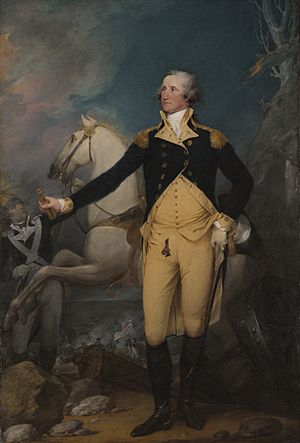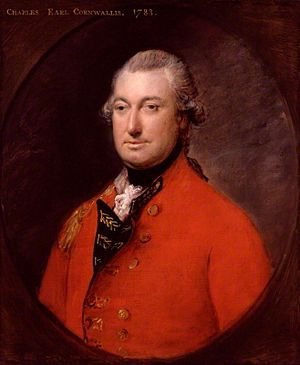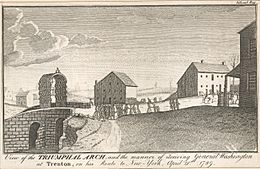Battle of the Assunpink Creek facts for kids
Quick facts for kids Battle of the Assunpink Creek |
|||||||
|---|---|---|---|---|---|---|---|
| Part of the New York and New Jersey campaign | |||||||
 General George Washington at Trenton, by the Assunpink Creek on the night of the battle, painting by John Trumbull |
|||||||
|
|||||||
| Belligerents | |||||||
| Commanders and leaders | |||||||
| Strength | |||||||
| 6,000 40 guns |
5,000 28 guns |
||||||
| Casualties and losses | |||||||
| 7–100 killed or wounded | 55–365 killed, wounded or captured | ||||||
The Battle of the Assunpink Creek, also known as the Second Battle of Trenton, was an important fight during the American Revolutionary War. It happened on January 2, 1777, in Trenton, New Jersey. American soldiers fought against British troops and won.
Just a few days before, on December 26, 1776, General George Washington and his Continental Army had won the Battle of Trenton. After that victory, Washington and his officers knew the British would try to strike back. So, they decided to get ready for a fight in Trenton. They set up their defenses south of a small stream called the Assunpink Creek.
British Lieutenant General Charles Cornwallis led his forces towards Trenton. He left about 1,400 men in Princeton and marched with 5,000 soldiers to Trenton on January 2. American riflemen, led by Edward Hand, slowed down Cornwallis's advance. They fought small battles along the way. The British didn't reach Trenton until evening.
Cornwallis's troops attacked the American defenses three times, but they were pushed back each time. Cornwallis then decided to wait until the next morning to finish the battle. But during the night, Washington moved his army secretly around Cornwallis's camp. The next day, Washington attacked the British troops left in Princeton. This surprise attack led to another American victory, which made the British pull back from most of New Jersey for the winter.
Contents
Why Did This Battle Happen?
On the night of December 25–26, 1776, General George Washington led his army across the Delaware River. This was a very risky move. They then attacked the Hessian soldiers (German troops fighting for the British) in the Battle of Trenton. The Hessians were quickly defeated. Washington then took his army back to Pennsylvania.
On December 30, Washington brought his army back to Trenton. He positioned his soldiers on the south side of the Assunpink Creek. This was a good defensive spot.
Getting Ready for the Fight
Washington's Important Speech
In Trenton, Washington faced a big problem. Most of his soldiers' enlistment (their time in the army) was ending on December 31. He knew his army would fall apart if he couldn't convince them to stay.
So, on December 30, Washington asked his men to stay for one more month. He offered them ten dollars as a bonus. At first, no one stepped forward. Washington then rode in front of his troops and gave a powerful speech. He told them, "My brave fellows, you have done all I asked you to do... but your country is at stake, your wives, your houses and all that you hold dear." He asked them to stay just one more month to help the cause of liberty. After a moment, one soldier stepped forward, and then most of the others followed.
Preparing the Defenses
On January 1, 1777, money arrived from the Continental Congress (the government of the American colonies). The soldiers were paid. Washington also received new orders from Congress. These orders gave him special powers to make quick decisions, almost like a military leader with full control.
Washington decided to stand and fight in Trenton. He ordered General John Cadwalader to bring his 1,800 militia (citizen soldiers) from Crosswicks to Trenton. On December 31, Washington learned that a large British army of 8,000 men, led by General Cornwallis, was coming to attack him.
Washington told his men to build earthworks (dirt walls) along the south bank of the Assunpink Creek. These defenses stretched for about three miles. However, one of Washington's helpers, Joseph Reed, pointed out that the British could cross the creek further upstream. This would allow them to attack the American army from the side. Washington couldn't escape across the Delaware River because his boats were too far away. Washington told his officers that their current position was only temporary and he planned to move the army later.
British March to Trenton
General Cornwallis had planned to go back to Britain, but his leave was canceled. He rode to Princeton to meet General James Grant. Grant had moved 1,000 troops to Princeton to help. Cornwallis arrived and was convinced by Grant and Carl von Donop to attack Trenton with their combined forces.
By January 1, 1777, Cornwallis and his army were in Princeton. On January 2, Cornwallis left some of his force there under Charles Mawhood. With 5,500 men, Cornwallis set off for Trenton, which was about 11 miles (18 km) away. Cornwallis's army had 28 cannons and marched in three groups. When they reached Maidenhead (now Lawrenceville), Cornwallis sent Colonel Alexander Leslie with 1,500 men to stay there until the next morning.
The Battle Begins
Slowing Down the British
Cornwallis sent out a group of Hessian jägers (skilled German riflemen) and British light infantry (fast-moving soldiers) ahead of his main army. Two days earlier, Washington had placed American troops under Matthias Alexis Roche de Fermoy to create an outer defense line. This line was halfway between Trenton and Princeton. Its job was to slow down the British. As the British got closer, Fermoy went back to Trenton, and Colonel Edward Hand took over his command.
When the British came within range, the American riflemen started firing. The Americans hid in the woods, in ravines (small valleys), and even in bends in the road. Each time the British formed a battle line, the riflemen would fall back and fire from cover.
After Hand had to leave the American position along Five Mile Run, he moved to a new spot. This was a heavily wooded area on the south bank of Shabakunk Creek. Hand placed his men among the trees. They were so well hidden that the British couldn't see them as they crossed the bridge over the stream. The riflemen fired at them from very close range. The intense firing made the British think they were fighting the entire American army. They formed battle lines and brought up their cannons. The British searched the woods for about half an hour, but Hand had already moved his men to another position.
By three in the afternoon, the British reached a ravine called Stockton Hollow. This was about half a mile (0.8 km) from Trenton. The Americans were forming another defense line there. Washington wanted to hold off the British until nightfall. Darkness would stop the British from attacking his main defenses on the south side of Assunpink Creek. The British, with their cannons ready, attacked Hand's new position. Hand's men slowly fell back into Trenton. Along the way, Hand had his troops fire from behind houses. As Hand's troops reached the creek, the Hessians charged at them with bayonets (knives on the end of rifles). This caused some confusion among the Americans. Washington saw this and rode out to the bridge. He shouted for Hand's rear guard (the soldiers at the back) to pull back and regroup under the protection of the American cannons.
British Attacks on the Bridge
As the British got ready to attack the American defenses, cannons and muskets fired back and forth. The British moved across the bridge in thick columns. The Americans all fired together. The British fell back for a moment. They charged the bridge again but were driven back by cannon fire. The British charged one last time. This time, the Americans fired canister shot (a type of cannonball filled with small metal balls). This shot ripped through the British lines, causing many casualties.
Washington's Clever Plan
Cornwallis's Decision
When Cornwallis arrived in Trenton with his main army, he held a meeting with his officers. He wanted to decide if he should keep attacking. Cornwallis's quartermaster general, William Erskine, urged him to attack right away. He said, "If Washington is the General I take him to be, his army will not be found there in the morning."
But James Grant disagreed. He argued that the Americans had no way to retreat. He also said that the British troops were tired. He thought it would be better to attack in the morning after they had rested. Cornwallis didn't want to wait, but he decided it was better than attacking in the dark. Cornwallis famously said, "We've got the old fox safe now. We'll go over and bag him in the morning." Cornwallis then moved his army to a hill north of Trenton for the night.
Washington's Secret Move
During the night, the American cannons, led by Henry Knox, occasionally fired shells into Trenton. This was to keep the British awake and worried. Just like Cornwallis, Washington also held a meeting with his officers. He decided on a bold plan: he would take a little-known road, the Quaker road, to Princeton. His officers agreed to try to attack the British soldiers stationed there.
By 2 AM on January 3, the American army was on its way to Princeton. Washington left behind 500 men and two cannons. Their job was to keep the campfires burning and make noise with picks and shovels. This was to make the British think the Americans were still digging in. By morning, these men also left. When the British came to attack, all the American troops were gone!
Who Was Hurt?
It's hard to know exactly how many soldiers were hurt or killed. Some records say the Americans had 6 killed, 10 wounded, and 1 deserted at Stockton Hollow. Another source says 1 killed and 6 wounded for the whole day. Some historians say the Americans had about 100 killed and wounded.
For the British, some records show 1 Hessian killed at Five Mile Run. At Stockton Hollow, at least 10 were killed, 20 wounded, and 25 captured. Other records say 4 Hessians killed and 11 wounded. One historian says the British had 365 killed, wounded, or captured in total.
What Happened Next?
By the morning of January 3, Washington had reached Princeton. After a short but fierce battle, the British troops there were defeated. Many of them were captured. This was the British army's third defeat in ten days.
General William Howe, Cornwallis's boss, ordered the British army to leave southern New Jersey. They moved back towards New York, leaving only a few soldiers in New Brunswick. Washington moved his army to Morristown for the winter.
Remembering the Battle
The Battle of the Assunpink Creek was remembered on April 21, 1789. A special arch was built over the bridge at Assunpink Creek. This was to celebrate George Washington's reception at Trenton as he traveled to his first inauguration as president.
In 1792, an American artist named John Trumbull painted a famous picture of Washington. It's called General George Washington at Trenton. It shows him after the battle, standing south of the bridge over the Assunpink Creek.
Images for kids
See Also
- American Revolutionary War §British New York counter-offensive – Learn where this battle fits into the bigger picture of the war.
- Battle of Trenton – This was the first battle in Trenton, fought just one week before.
- Battle of Princeton – This battle happened the very next day after Assunpink Creek.



